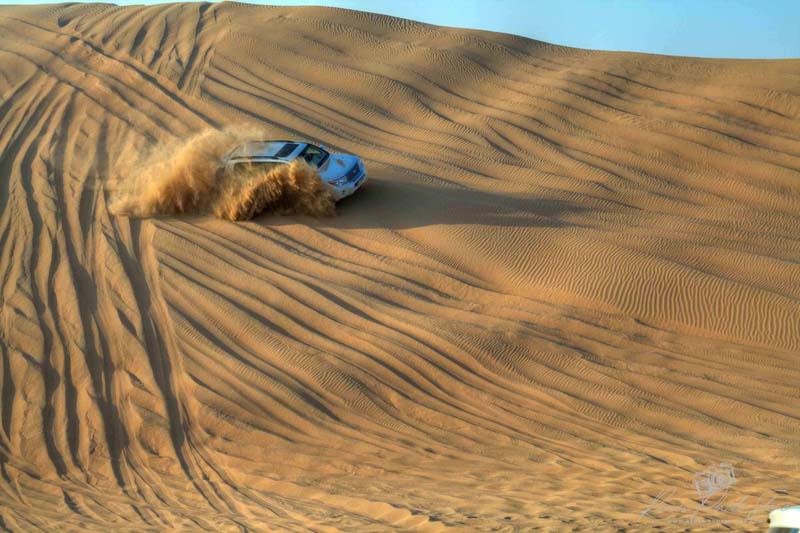The air was already warm at dawn, dry and tinged with the scent of sun-baked limestone and wild thyme. As I stepped out of the car just off the coastal highway between Muscat and Sur, the landscape unfolded in layers of ochre and rust—rocky escarpments glowing under the early sun, the Arabian Sea glinting faintly in the distance. But it wasn’t the sea I had come for. It was what lay hidden in the earth: a wound of nature transformed into a jewel.
Descending a short, dusty path, I rounded a bend—and there it was.
The Bimmah Sinkhole, nestled in the Hadjar Mountains of eastern Oman, yawned open like a secret whispered by the planet. About 100 meters wide and 20 meters deep, its bowl-shaped cavity cradled a pool of water so vividly turquoise it looked unreal—like liquid gemstone poured into the heart of the desert. Morning light slanted across the limestone walls, illuminating fractures and fossils embedded in the rock, while the surface of the water shimmered with ripples stirred by a lone swimmer below. The sound of laughter echoed upward, bouncing off the stone like wind chimes in a silent cathedral.
I stood at the edge, breath caught in my throat. This wasn’t just a geological anomaly. It was a portal—a place where earth, water, and time converged in breathtaking harmony.
Where Earth Cracked Open: The Making of a Natural Wonder
Located just outside the village of Bimmah, about 120 kilometers southeast of Muscat in the Ash Sharqiyah region, the sinkhole—known locally as Hawiyyat Najm, or “the Falling Star” —is one of Oman’s most photographed natural landmarks. Its name, Bimmah Sinkhole, has become synonymous with adventure, beauty, and mystery.
Geologically, it’s a solution sinkhole, formed over millennia as rainwater—slightly acidic from dissolved carbon dioxide—seeped through cracks in the limestone bedrock, slowly dissolving the stone beneath. Eventually, the roof collapsed, revealing the aquifer below. What emerged wasn’t just a hole, but a masterpiece: a natural amphitheater filled with cool, mineral-rich groundwater fed by underground springs. The striking blue-green hue comes from a mix of dissolved minerals and sunlight refracting through the clear water.
But science only tells half the story.
Locals whisper a more poetic origin: that the sinkhole was created when a meteorite fell from the sky, leaving behind this celestial scar. Hawiyyat Najm literally means “the Well of the Falling Star,” and though geologists confirm no meteorite impact occurred, the legend persists—woven into the cultural fabric of the region like the fossils embedded in the surrounding rock.
And yes—those fossils are real. If you look closely at the walls, you’ll see ancient seashells and coral imprints, silent witnesses to a time when this arid region lay beneath a shallow sea over 90 million years ago. Oman, it turns out, is a living museum of Earth’s deep history.
A Place Between Worlds: Nature, Culture, and Tourism
Today, the Bimmah Sinkhole is both a natural sanctuary and a pilgrimage for travelers. Managed by Oman’s Ministry of Heritage and Tourism, the site is clean, safe, and accessible—complete with walkways, shaded rest areas, and ladders into the water. Yet despite the infrastructure, it retains an aura of wildness. There are no loudspeakers, no vendors shouting for attention—just the hum of cicadas, the splash of swimmers, and the occasional call to prayer drifting from a distant village.
For Omanis, places like Bimmah represent more than scenic beauty. They are tangible connections to the land’s resilience and mystery. In a country where desert and mountain meet the sea, natural wonders are revered not just for their aesthetics, but for their spiritual and historical weight. The sinkhole, though not a religious site, is treated with respect—no graffiti, no litter, no loud music. Visitors swim quietly, float on their backs, or simply sit at the rim, gazing into the depths.
Tourism here is growing, but thoughtfully managed. Unlike overcrowded attractions elsewhere, Bimmah remains intimate. On the weekday morning I visited, there were only a handful of others—families from Muscat enjoying a weekend escape, foreign hikers refilling water bottles before heading into the nearby Wadi Shab, and a few photographers like me, waiting for the perfect light.
And oh, the light.
By mid-morning, the sun had risen directly overhead, turning the pool into a luminous aquamarine lens. The contrast between the warm, golden limestone and the cool, electric water created a visual tension that felt almost cinematic. The composition was effortless: the circular shape of the sinkhole framing the sky, the human figure in the water adding scale and soul. It was a moment of pure balance—between earth and sky, solitude and connection, nature and narrative.
Why This Image Captures the Soul of Oman
This photograph—of sunlight slicing through the stillness, of water so clear it seems to erase the boundary between surface and depth—doesn’t just document a place. It evokes a feeling: the awe of discovering something ancient and untouched, even in an age of GPS and instant travel.
The emerald pool, the fossil-streaked cliffs, the solitary swimmer—they come together to tell a story of time, transformation, and wonder. It’s a reminder that the most powerful landscapes aren’t always the tallest mountains or widest deserts, but the ones that invite you in—literally and emotionally.
For interior designers, this image brings the serenity of natural oasis into homes and offices—ideal as a large-format canvas print, digital frame feature, or statement piece in wellness spaces. For educators and publishers, it’s a compelling visual for stories on geology, conservation, or Middle Eastern ecotourism. For travelers and dreamers, it’s a postcard from a land where beauty rises from the cracks.
Own This Moment: High-Resolution Digital Download
This image is available as a high-resolution digital download—no physical product included.
Captured at the peak of morning clarity, the file delivers crisp detail, museum-grade resolution, and rich color depth, optimized for both large-format printing and digital use. Whether you're creating wall art, designing a travel brochure, or curating a visual story, this photo offers unmatched versatility.
- Ideal for: Home decor, office spaces, travel blogs, editorial features, design projects
- Perfect for: Interior designers, educators, marketers, publishers, and photography collectors
- License: Suitable for commercial and editorial use—ideal for travel brands, tourism campaigns, and creative media
Instant access. Timeless beauty. A piece of Oman’s soul, now yours to share.
Download today and bring the magic of the Bimmah Sinkhole into your world.



